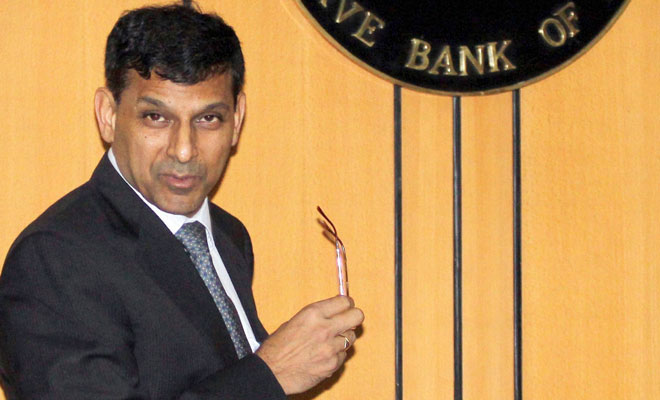Photographs: Danish Siddiqui/Reuters Suvashree Dey Choudhury and Subhadip Sircar
The era of easy money for Indian banks may be coming to an end. Unlimited access to cheap overnight funding from the Reserve Bank of India (RBI) was tightened mid-year as part of measures to support a plunging rupee, and now the central bank is keen to use the restrictions to help it deepen money markets.
The ability of banks to continuously tap funds through the central bank's Liquidity Adjustment Facility (LAF) lowers their need to raise cash in the markets, which has thwarted the development of a proper money-market yield curve.
That seems set to change under new Governor Raghuram Rajan, who has pledged to deepen and develop India's financial markets. As a first step, he wants to encourage use of new term repos.
Sources say the RBI will deliberately go slow in removing the cap on funds banks can borrow via the LAF, even as it unwinds other emergency measures imposed to prop up the rupee.
Having a money-market yield curve would help investors and companies better price risk across a range of maturities, and should make markets more liquid.
"Globally, many central banks rely more on term lending than overnight lending. We also want to move to that kind of a system where the reliance on overnight borrowing from the RBI will be reduced to the minimum. This will help in building a smooth yield curve," said an official aware of the issue.
Click on NEXT for more...
India pushes to develop money markets
Photographs: Reuters
Turning off the tap
Under the LAF, banks borrow overnight funds at the central bank's main lending rate, the repo rate, currently at 7.75 percent.
The facility is intended to help lenders smooth over daily fluctuations in their liquidity needs, but banks have instead used it to borrow easy money, and fund longer-term lending by repeatedly rolling over their collateral.
That changed since mid-year when the RBI limited borrowing first to 1 percent of bank deposits and then to 0.50 percent, about 400 billion rupees daily, in measures to tighten the supply of rupees and support its exchange rate.
"LAF is a liquidity management tool. But banks are using it to fund their loan book and they are not very actively mobilising deposits," said a second official familiar with the central bank's thinking.
Estimates are that banks now have to raise at least about 800 billion rupees each day outside of the LAF.
Some of that can be tapped via other central bank facilities, including an export refinance window where funds are borrowed at the repo rate, and the Marginal Standing Facility, emergency funding at a more punitive rate of 8.75 percent.
Banks can also raise funds from 7-day and 14-day term repurchase agreements (repos) that were launched in October. The first three auctions have attracted strong demand, and the RBI can eventually add more tenors to create a yield curve.
Click on NEXT for more...
India pushes to develop money markets
Photographs: Reuters
Adjustment
Having become accustomed to unlimited low-cost cash, the shift to market-based funding has led to some volatility as banks adjust to the new environment.
The Mumbai Inter-Bank Offer Rate, or MIBOR, an overnight rate that determines the pricing of short-term debt such as commercial paper, is moving in a range of about 100 basis points, compared with 10 to 20 basis points in mid-July.
Last week, MIBOR was at 8.80 percent, higher than even the 8.75 percent the RBI charges for emergency funding. But bankers acknowledge the long-term benefits of creating a yield curve.
"We are using the term repo facility. We are not facing any issues due to the repo cap. The RBI should gradually move to longer tenors to cover the duration till the 91-day T-bills. It will eventually help the development of an interbank term money market," said N. S. Venkatesh, treasurer at IDBI Bank.
It is not just a matter of commercial banks changing their practices. The Reserve Bank may also need to change some of its rules before the money markets can fully develop.
One of the major issues seen restricting the interbank term repo market is a set of regulations preventing collateral pledged in a repo being reused by the party providing the funds, a common feature in more developed markets.
"The RBI is trying to wean away banks from using the overnight window to support their balance-sheet activities," said R. Sivakumar, head of fixed income at Axis Mutual Fund.
"The ultimate success will be if they can develop a term money market outside the central bank's window."
Additional reporting Swati Bhat and Archana Narayanan





article